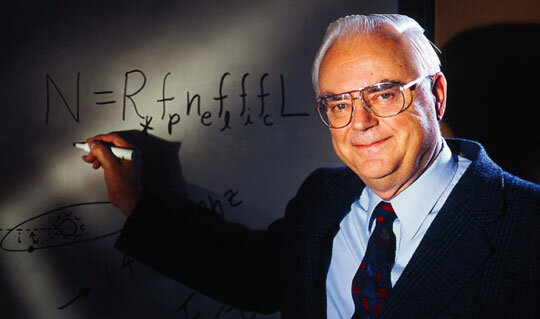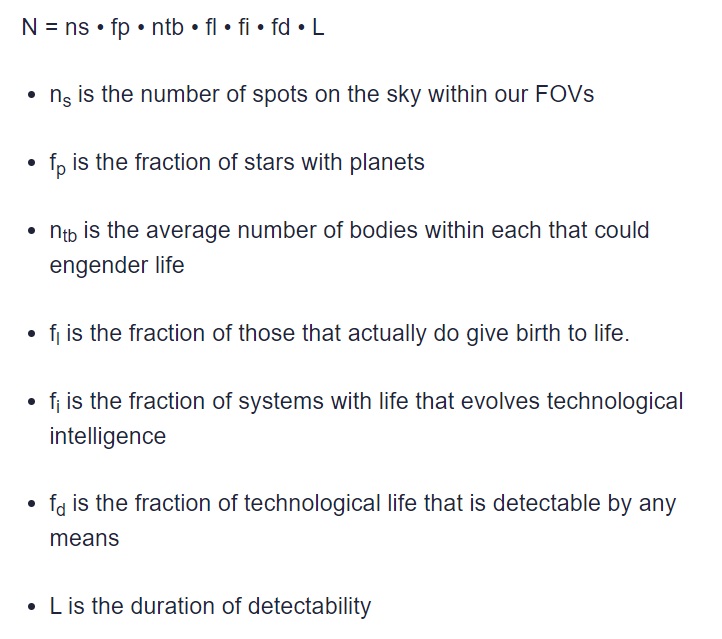
May 28, 2021, is the 91st birthday of astronomer Frank Drake, an early visionary in the search for other civilizations in our Milky Way galaxy. In 1960, Drake spearheaded Project Ozma, the first modern attempt to listen for radio transmissions from otherworldly intelligences. Then, on November 1, 1961, Drake, Carl Sagan and other astronomers met at the site of the Green Bank Telescope in Green Bank, West Virginia. At that meeting, Drake presented what has become known as the Drake Equation.
Scientists and the public found the Drake Equation fascinating then, and they still do. It’s a tool for contemplating how many intelligent civilizations might be capable of communicating with us from elsewhere in the galaxy. From Drake’s formulation of the equation – and the 1961 meeting in Green Bank – the field of research and scientific organization known as SETI, the search for extraterrestrial intelligence, was born.
What is the Drake Equation?
The Drake Equation is a mathematical formula for thinking about how many civilizations beyond Earth might be able to communicate with us. Nowadays when you hear astronomers speak of life beyond Earth, they might be focused on biosignatures, evidence of life, from simple or multicellular life. That is, they might be speaking of possible life forms under rocks on Mars or in the atmosphere of Venus. The Drake Equation focuses on something different. It’s the search for advanced and communicating civilizations.
This is the Drake Equation: N = R* • fp • ne • fl • fi • fc • L
Broken down, the equation is as follows:

As originally formulated, the Drake Equation is less a true mathematical formula and more a way to start a conversation. The value of N – the number of civilizations with which we might communicate – is difficult to determine if you don’t have solid numbers on all the factors that need to be considered. Do astronomers know the rate of star formation in our Milky Way? Yes, approximately. The rate of star formation is somewhere around 3 solar masses per year. Do they know how many stars form planets? We didn’t know that number in 1961, but now the answer is thought to be: most, if not all, of them.
But, as you go onward in the equation, the state of our knowledge begins to falter. We don’t know the mean number of planets that could support life per star with planets. We don’t know the fration of life-supporting planets that develop life. And so on.
Drake Equation revisited
In recent years, the Drake Equation has inspired fresh thinking about extraterrestrial life among astronomers. In 2016, Adam Frank and Woodruff Sullivan put their heads together to publish a paper in the journal Astrobiology in which they presented the Drake Equation in a new light. They noted that technological advancements in astronomy had made possible better estimates of two Drake equation factors:
The fraction of stars with planets, fp, is now estimated to be 1.0, meaning all stars have planets
The number of planets per star where conditions are suitable for life, ne, is now estimated to be 0.2, meaning one in five planets can support life
In May 2021, John Gertz made a case for rewriting the Drake Equation in a paper accepted for publication by the Journal of the British Interplanetary Society. Here are Gertz’s thoughts on the Drake Equations variables:
R*, the mean rate of star formation, is a problem, Gertz suggests, because the rate of new star formation changes over the history of our galaxy. Plus what about other galaxies? The rate of star formation would be different. In his May 2021 paper, Gertz suggested changing R* to Ns: the number of candidate stars in the Milky Way that fall within our field of view. He pointed out that 80% of these stars would be stars not so very different from our sun.
Fp, the fraction of stars that have planets, is no longer a big unknown, since we now know that planets around stars are quite common.
Ne, the number of rocky planets in a star’s habitable zone, is too limiting, Gertz suggested. The presence of an atmosphere and water are important considerations, but so are the countless moons where life could exist around planets outside a star’s habitable zone. Gertz recommends replacing this variable with Ntb, which stands for the total number of bodies that could support life on or beneath their surfaces.
Fl, the fraction of planets that actually develop life, is unknowable at this time. The origin of life on Earth is still not completely understood, much less how common or rare it is in the universe.
Fi, the fraction of planets with life that develop intelligence, is also unknowable. If we don’t know how common life may be in the universe, we don’t know how common intelligent life may be.
Fc, the fraction of intelligent civilizations technologically capable and actively trying to communicate with us, doesn’t take into consideration the vast expanses that communication would have to travel between our home worlds. But we could also unintentionally stumble across a signal (perhaps the Wow! signal?). A better variable, Gertz says, is Fd, the fraction of technological life that is detectable by any means. The problem may not be the civilization sending us a message, the problem could be that we aren’t advanced enough to detect or receive it.
L, the length of time a civilization is communicative, depends on how long they can sustain themselves before they either self-destruct or something external (asteroid, supernova or the like) takes them out. We don’t know the answer, either for ourselves or for an alien civilization. This variable is the one that Carl Sagan considered most uncertain. Gertz’s ideas about L mesh nicely with Avi Loeb’s assertion that ‘Oumuamua is of alien origin. Gertz commented:
The Drake equation was predicated upon the notion that there is a finite number of currently existing alien civilizations ensconced among the stars, some of whom will be signaling their presence to us using radio or optical lasers. However, this ignores another school of thought which holds that ET’s far better strategy would be to send physical probes to our solar system to surveil and ultimately make contact with us. Such probes could represent information from innumerable civilizations, many of whom may have long ago perished. If this is the case, Drake’s L is irrelevant, since the probe might far outlive its progenitor, and his N reduces to one, the single probe that makes its presence known to us through which alone we might communicate with the rest of the galaxy.
What’s left is John Gertz’s updated take on the Drake Equation: N = ns • fp • ntb • fl • fi • fd • L

Frank Drake knew the uncertainties
Even with this new formula, as when Drake originally formulated his equation, uncertainty pervades. Gertz said:
The Drake equation sets out to determine N, the number of extant communicating civilizations. There is simply no way to determine this by any known means other than by making contact with our first ET and asking it what it might know of the matter. The failure of the Drake equation paradoxically makes a robust SETI program all the more important, since no amount of armchair speculation can determine N.
Where do SETI researchers go from here?
The plan is for radio wave and visible-light observations, combined with technological advances that will eventually let scientists survey one million nearby stars, the entire galactic plane and 100 nearby galaxies. Dedicated wide-field telescopes are one of the items on Gertz’s wish list for SETI.
Breakthrough Listen, a project Gertz is currently involved in, is a good start. It is the largest-ever scientific research program aimed at finding evidence of civilizations beyond Earth. Breakthrough Listen scans the radio spectrum with the world’s most powerful instruments. Gertz said:
Breakthrough Listen is a game-changer. Because of it, more SETI is accomplished in a single day than was ever before accomplished in a full year.
Funding will be the key to continued searches, and, with a lot of planning and maybe a little luck, to future success in finding an intelligent civilization in the wider universe.

Video resources on the Drake Equation
For a more in-depth discussion about the Drake Equation, watch the following two-part videos of 25 minutes each hosted by David Kipping of Columbia University.
Bottom line: May 28, 2021, is the 91st birthday of astronomer Frank Drake, an early visionary in the search for other civilizations in our Milky Way galaxy and formulator of the Drake Equation. In May 2021, John Gertz suggested reformulating the Drake Equation.
Source: The Drake Equation at 60 [Gertz]
Via Phys.org and FamousScientists.org
The post Happy birthday, Frank Drake first appeared on EarthSky.
from EarthSky https://ift.tt/3uuAepU

May 28, 2021, is the 91st birthday of astronomer Frank Drake, an early visionary in the search for other civilizations in our Milky Way galaxy. In 1960, Drake spearheaded Project Ozma, the first modern attempt to listen for radio transmissions from otherworldly intelligences. Then, on November 1, 1961, Drake, Carl Sagan and other astronomers met at the site of the Green Bank Telescope in Green Bank, West Virginia. At that meeting, Drake presented what has become known as the Drake Equation.
Scientists and the public found the Drake Equation fascinating then, and they still do. It’s a tool for contemplating how many intelligent civilizations might be capable of communicating with us from elsewhere in the galaxy. From Drake’s formulation of the equation – and the 1961 meeting in Green Bank – the field of research and scientific organization known as SETI, the search for extraterrestrial intelligence, was born.
What is the Drake Equation?
The Drake Equation is a mathematical formula for thinking about how many civilizations beyond Earth might be able to communicate with us. Nowadays when you hear astronomers speak of life beyond Earth, they might be focused on biosignatures, evidence of life, from simple or multicellular life. That is, they might be speaking of possible life forms under rocks on Mars or in the atmosphere of Venus. The Drake Equation focuses on something different. It’s the search for advanced and communicating civilizations.
This is the Drake Equation: N = R* • fp • ne • fl • fi • fc • L
Broken down, the equation is as follows:

As originally formulated, the Drake Equation is less a true mathematical formula and more a way to start a conversation. The value of N – the number of civilizations with which we might communicate – is difficult to determine if you don’t have solid numbers on all the factors that need to be considered. Do astronomers know the rate of star formation in our Milky Way? Yes, approximately. The rate of star formation is somewhere around 3 solar masses per year. Do they know how many stars form planets? We didn’t know that number in 1961, but now the answer is thought to be: most, if not all, of them.
But, as you go onward in the equation, the state of our knowledge begins to falter. We don’t know the mean number of planets that could support life per star with planets. We don’t know the fration of life-supporting planets that develop life. And so on.
Drake Equation revisited
In recent years, the Drake Equation has inspired fresh thinking about extraterrestrial life among astronomers. In 2016, Adam Frank and Woodruff Sullivan put their heads together to publish a paper in the journal Astrobiology in which they presented the Drake Equation in a new light. They noted that technological advancements in astronomy had made possible better estimates of two Drake equation factors:
The fraction of stars with planets, fp, is now estimated to be 1.0, meaning all stars have planets
The number of planets per star where conditions are suitable for life, ne, is now estimated to be 0.2, meaning one in five planets can support life
In May 2021, John Gertz made a case for rewriting the Drake Equation in a paper accepted for publication by the Journal of the British Interplanetary Society. Here are Gertz’s thoughts on the Drake Equations variables:
R*, the mean rate of star formation, is a problem, Gertz suggests, because the rate of new star formation changes over the history of our galaxy. Plus what about other galaxies? The rate of star formation would be different. In his May 2021 paper, Gertz suggested changing R* to Ns: the number of candidate stars in the Milky Way that fall within our field of view. He pointed out that 80% of these stars would be stars not so very different from our sun.
Fp, the fraction of stars that have planets, is no longer a big unknown, since we now know that planets around stars are quite common.
Ne, the number of rocky planets in a star’s habitable zone, is too limiting, Gertz suggested. The presence of an atmosphere and water are important considerations, but so are the countless moons where life could exist around planets outside a star’s habitable zone. Gertz recommends replacing this variable with Ntb, which stands for the total number of bodies that could support life on or beneath their surfaces.
Fl, the fraction of planets that actually develop life, is unknowable at this time. The origin of life on Earth is still not completely understood, much less how common or rare it is in the universe.
Fi, the fraction of planets with life that develop intelligence, is also unknowable. If we don’t know how common life may be in the universe, we don’t know how common intelligent life may be.
Fc, the fraction of intelligent civilizations technologically capable and actively trying to communicate with us, doesn’t take into consideration the vast expanses that communication would have to travel between our home worlds. But we could also unintentionally stumble across a signal (perhaps the Wow! signal?). A better variable, Gertz says, is Fd, the fraction of technological life that is detectable by any means. The problem may not be the civilization sending us a message, the problem could be that we aren’t advanced enough to detect or receive it.
L, the length of time a civilization is communicative, depends on how long they can sustain themselves before they either self-destruct or something external (asteroid, supernova or the like) takes them out. We don’t know the answer, either for ourselves or for an alien civilization. This variable is the one that Carl Sagan considered most uncertain. Gertz’s ideas about L mesh nicely with Avi Loeb’s assertion that ‘Oumuamua is of alien origin. Gertz commented:
The Drake equation was predicated upon the notion that there is a finite number of currently existing alien civilizations ensconced among the stars, some of whom will be signaling their presence to us using radio or optical lasers. However, this ignores another school of thought which holds that ET’s far better strategy would be to send physical probes to our solar system to surveil and ultimately make contact with us. Such probes could represent information from innumerable civilizations, many of whom may have long ago perished. If this is the case, Drake’s L is irrelevant, since the probe might far outlive its progenitor, and his N reduces to one, the single probe that makes its presence known to us through which alone we might communicate with the rest of the galaxy.
What’s left is John Gertz’s updated take on the Drake Equation: N = ns • fp • ntb • fl • fi • fd • L

Frank Drake knew the uncertainties
Even with this new formula, as when Drake originally formulated his equation, uncertainty pervades. Gertz said:
The Drake equation sets out to determine N, the number of extant communicating civilizations. There is simply no way to determine this by any known means other than by making contact with our first ET and asking it what it might know of the matter. The failure of the Drake equation paradoxically makes a robust SETI program all the more important, since no amount of armchair speculation can determine N.
Where do SETI researchers go from here?
The plan is for radio wave and visible-light observations, combined with technological advances that will eventually let scientists survey one million nearby stars, the entire galactic plane and 100 nearby galaxies. Dedicated wide-field telescopes are one of the items on Gertz’s wish list for SETI.
Breakthrough Listen, a project Gertz is currently involved in, is a good start. It is the largest-ever scientific research program aimed at finding evidence of civilizations beyond Earth. Breakthrough Listen scans the radio spectrum with the world’s most powerful instruments. Gertz said:
Breakthrough Listen is a game-changer. Because of it, more SETI is accomplished in a single day than was ever before accomplished in a full year.
Funding will be the key to continued searches, and, with a lot of planning and maybe a little luck, to future success in finding an intelligent civilization in the wider universe.

Video resources on the Drake Equation
For a more in-depth discussion about the Drake Equation, watch the following two-part videos of 25 minutes each hosted by David Kipping of Columbia University.
Bottom line: May 28, 2021, is the 91st birthday of astronomer Frank Drake, an early visionary in the search for other civilizations in our Milky Way galaxy and formulator of the Drake Equation. In May 2021, John Gertz suggested reformulating the Drake Equation.
Source: The Drake Equation at 60 [Gertz]
Via Phys.org and FamousScientists.org
The post Happy birthday, Frank Drake first appeared on EarthSky.
from EarthSky https://ift.tt/3uuAepU

Aucun commentaire:
Enregistrer un commentaire